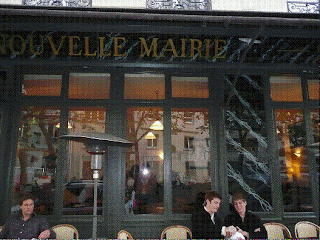On a blistering cold evening last year in Café de la Nouvelle Mairie, a Paris
As far as I could tell, listening from distance and observing gestures, the vigneron was unknown to the bistro owner. He gently grabbed and leaned over to the passing-by waitor and spoke to him. Within minutes, there were a bowl of warming soup, a plate of terrine and some bread on the table. A plate of duck confit followed. The bistro owner said something to the vigneron and left temporarily. The vigneron indeed must have been hungry because the plates of foods were emptied quickly.
About ½ hour later, the bistro owner returned with a plate of cheese and a couple of wine glasses. The bistro owner and vigneron were now tasting the wines that the vigneron had brought with him. I can clearly tell the bistro owner was very impressed with the wines. It was no longer a tasting as the bistro owner was now thoroughly enjoying the wines.
The bistro owner left the table and brought more plates of food. Now, the vigneron and bistro owner were enjoying the wines with the food. The bistro owner gestured to the sommelier, who was busy behind the zinc bar, to join. The conversation ensued and I could sense a friendship bonding. Their unexpected get together ended with a cup of espresso and sincerest handshake. The vigneron reached his wallet to pay for the meal. The bistro owner would have none of it and said in words that I can barely make out from the distance: “I look forward to your wine delivery next week.”
After I finished my meal with a cup of espresso, I stepped outside of the bistro to return to my hotel. The outside felt much warmer than I had remembered.
Happy Holidays.

























